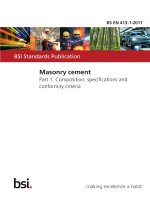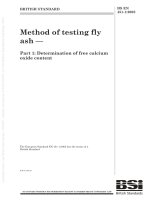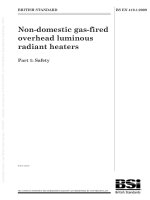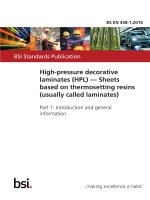Bsi bs en 61427 1 2013
Bạn đang xem bản rút gọn của tài liệu. Xem và tải ngay bản đầy đủ của tài liệu tại đây (1.05 MB, 22 trang )
BS EN 61427-1:2013
BSI Standards Publication
Secondary cells and batteries
for renewable energy storage
— General requirements and
methods of test Part 1: Photovoltaic off-grid application
BS EN 61427-1:2013
BRITISH STANDARD
National foreword
This British Standard is the UK implementation of EN 61427-1:2013. It is
identical to IEC 61427-1:2013. Together with BS EN 61427-2, it supersedes
BS EN 61427:2005 which will be withdrawn upon publication of all parts
of this series.
The UK participation in its preparation was entrusted to Technical
Committee PEL/21, Secondary cells and batteries.
A list of organizations represented on this subcommittee can be
obtained on request to its secretary.
This publication does not purport to include all the necessary provisions
of a contract. Users are responsible for its correct application.
© The British Standards Institution 2014.
Published by BSI Standards Limited 2014
ISBN 978 0 580 74813 4
ICS 27.160; 29.220.20
Compliance with a British Standard cannot confer immunity from
legal obligations.
This British Standard was published under the authority of the Standards
Policy and Strategy Committee on 31 January 2014.
Amendments/corrigenda issued since publication
Date
Text affected
BS EN 61427-1:2013
EN 61427-1
EUROPEAN STANDARD
NORME EUROPÉENNE
EUROPÄISCHE NORM
July 2013
ICS 27.160; 29.220.20
Supersedes EN 61427:2005
English version
Secondary cells and batteries for renewable energy storage General requirements and methods of test Part 1: Photovoltaic off-grid application
(IEC 61427-1:2013)
Accumulateurs pour le stockage de
l'énergie renouvelable Exigences générales et méthodes
d'essais Partie 1: Applications photovoltaïques
hors réseaux
(CEI 61427-1:2013)
Wiederaufladbare Zellen und Batterien für
die Speicherung erneuerbarer Energien Allgemeine Anforderungen und
Prüfverfahren Teil 1: Photovoltaische netzunabhängige
Anwendung
(IEC 61427-1:2013)
This European Standard was approved by CENELEC on 2013-05-28. CENELEC members are bound to comply
with the CEN/CENELEC Internal Regulations which stipulate the conditions for giving this European Standard
the status of a national standard without any alteration.
Up-to-date lists and bibliographical references concerning such national standards may be obtained on
application to the CEN-CENELEC Management Centre or to any CENELEC member.
This European Standard exists in three official versions (English, French, German). A version in any other
language made by translation under the responsibility of a CENELEC member into its own language and notified
to the CEN-CENELEC Management Centre has the same status as the official versions.
CENELEC members are the national electrotechnical committees of Austria, Belgium, Bulgaria, Croatia, Cyprus,
the Czech Republic, Denmark, Estonia, Finland, Former Yugoslav Republic of Macedonia, France, Germany,
Greece, Hungary, Iceland, Ireland, Italy, Latvia, Lithuania, Luxembourg, Malta, the Netherlands, Norway, Poland,
Portugal, Romania, Slovakia, Slovenia, Spain, Sweden, Switzerland, Turkey and the United Kingdom.
CENELEC
European Committee for Electrotechnical Standardization
Comité Européen de Normalisation Electrotechnique
Europäisches Komitee für Elektrotechnische Normung
Management Centre: Avenue Marnix 17, B - 1000 Brussels
© 2013 CENELEC -
All rights of exploitation in any form and by any means reserved worldwide for CENELEC members.
Ref. No. EN 61427-1:2013 E
BS EN 61427-1:2013
EN 61427-1:2013
-2-
Foreword
The text of document 21/793/FDIS, future edition 1 of IEC 61427-1, prepared by IEC/TC 21 "Secondary
cells and batteries" was submitted to the IEC-CENELEC parallel vote and approved by CENELEC as
EN 61427-1:2013.
The following dates are fixed:
•
•
latest date by which the document has
to be implemented at national level by
publication of an identical national
standard or by endorsement
latest date by which the national
standards conflicting with the
document have to be withdrawn
(dop)
2014-02-28
(dow)
2016-05-28
This document supersedes EN 61427:2005.
EN 61427-1:2013 includes the following significant technical changes with respect to EN 61427:2005:
a) a restructuration of the previous edition of the document;
b) a clarification of the different clauses with regard to conditions of use, general requirements, functional
characteristics, general tests conditions, test method and recommended use of tests, the aim being to
ensure a better understanding by the end user;
c) a clear distinction between on-grid and off-grid applications for future markets needs.
Attention is drawn to the possibility that some of the elements of this document may be the subject of
patent rights. CENELEC [and/or CEN] shall not be held responsible for identifying any or all such patent
rights.
Endorsement notice
The text of the International Standard IEC 61427-1:2013 was approved by CENELEC as a European
Standard without any modification.
In the official version, for Bibliography, the following note has to be added for the standard indicated:
IEC 60721-1
NOTE Harmonised as EN 60721-1.
BS EN 61427-1:2013
EN 61427-1:2013
-3-
Annex ZA
(normative)
Normative references to international publications
with their corresponding European publications
The following documents, in whole or in part, are normatively referenced in this document and are
indispensable for its application. For dated references, only the edition cited applies. For undated
references, the latest edition of the referenced document (including any amendments) applies.
NOTE When an international publication has been modified by common modifications, indicated by (mod), the relevant EN/HD
applies.
Publication
Year
Title
EN/HD
Year
IEC 60050
Series International Electrotechnical vocabulary (IEV) -
-
IEC 60622
-
Secondary cells and batteries containing
alkaline or other non-acid electrolytes Sealed nickel-cadmium prismatic
rechargeable single cells
EN 60622
-
IEC 60623
-
Secondary cells and batteries containing
alkaline or other non-acid electrolytes Vented nickel-cadmium prismatic
rechargeable single cells
EN 60623
-
IEC 60896-11
-
Stationary lead-acid batteries EN 60896-11
Part 11: Vented types - General requirements
and methods of tests
-
IEC 60896-21
-
Stationary lead-acid batteries Part 21: Valve regulated types - Methods of
test
EN 60896-21
-
IEC 61056-1
-
General purpose lead-acid batteries (valveregulated types) Part 1: General requirements, functional
characteristics - Methods of test
EN 61056-1
-
IEC 61836
-
Solar photovoltaic energy systems Terms, definitions and symbols
-
-
IEC 61951-1
-
Secondary cells and batteries containing
alkaline or other non-acid electrolytes Portable sealed rechargeable single cells Part 1: Nickel-cadmium
EN 61951-1
-
IEC 61951-2
-
Secondary cells and batteries containing
alkaline or other non-acid electrolytes Portable sealed rechargeable single cells Part 2: Nickel-metal hydride
EN 61951-2
-
IEC 61960
-
Secondary cells and batteries containing
alkaline or other non-acid electrolytes Secondary lithium cells and batteries for
portable applications
EN 61960
-
IEC 62259
-
Secondary cells and batteries containing
alkaline or other non-acid electrolytes Nickel-cadmium prismatic secondary single
cells with partial gas recombination
EN 62259
-
BS EN 61427-1:2013
–2–
61427-1 IEC:2013
CONTENTS
1
Scope ............................................................................................................................... 6
2
Normative references ....................................................................................................... 6
3
Terms and definitions ....................................................................................................... 7
4
Conditions of use.............................................................................................................. 7
4.1
4.2
4.3
4.4
5
General ................................................................................................................... 7
Photovoltaic energy system ..................................................................................... 7
Secondary cells and batteries .................................................................................. 7
General operating conditions ................................................................................... 8
4.4.1 General ....................................................................................................... 8
4.4.2 Autonomy time............................................................................................. 8
4.4.3 Typical charge and discharge currents ........................................................ 8
4.4.4 Daily cycle ................................................................................................... 8
4.4.5 Seasonal cycle ............................................................................................ 8
4.4.6 Period of high state of charge ...................................................................... 9
4.4.7 Period of sustained low state of charge ....................................................... 9
4.4.8 Electrolyte stratification ............................................................................... 9
4.4.9 Storage ....................................................................................................... 9
4.4.10 Operating temperature ............................................................................... 10
4.4.11 Charge control ........................................................................................... 11
4.4.12 Physical protection .................................................................................... 11
General requirements ..................................................................................................... 11
6
5.1 Mechanical endurance ........................................................................................... 11
5.2 Charge efficiency .................................................................................................. 12
5.3 Deep discharge protection ..................................................................................... 12
5.4 Marking ................................................................................................................. 12
5.5 Safety.................................................................................................................... 12
5.6 Documentation ...................................................................................................... 12
Functional characteristics ............................................................................................... 13
7
General test conditions ................................................................................................... 13
8
7.1 Accuracy of measuring instruments ....................................................................... 13
7.2 Preparation and maintenance of test batteries ....................................................... 13
Test method ................................................................................................................... 13
8.1
8.2
8.3
8.4
9
Capacity test ......................................................................................................... 13
Generic cycling endurance test.............................................................................. 14
Charge retention test ............................................................................................. 14
Cycling endurance test in photovoltaic applications (extreme conditions) .............. 14
8.4.1 General ..................................................................................................... 14
8.4.2 Phase A: shallow cycling at low state of charge (see Table 5) ................... 15
8.4.3 Phase B: shallow cycling at high state of charge (see Table 6) .................. 15
8.4.4 Residual capacity determination ................................................................ 16
8.4.5 Test termination......................................................................................... 16
8.4.6 Water consumption of flooded battery types and cells with partial gas
recombination ............................................................................................ 16
8.4.7 Requirements ............................................................................................ 16
Recommended use of tests ............................................................................................ 17
BS EN 61427-1:2013
61427-1 IEC:2013
–3–
9.1
9.2
Type test ............................................................................................................... 17
Acceptance test ..................................................................................................... 17
9.2.1 Factory test ............................................................................................... 17
9.2.2 Commissioning test ................................................................................... 17
Bibliography .......................................................................................................................... 18
Table 1 – Limit values for storage conditions of batteries for photovoltaic applications ......... 10
Table 2 – Limit values for operating conditions of batteries for photovoltaic
applications .......................................................................................................................... 10
Table 3 – Battery Ah-efficiency at different states of charge at the reference
temperature and a daily depth of discharge of less than 20 % of the rated capacity .............. 12
Table 4 – Typical capacity ratings of batteries in photovoltaic applications ............................ 14
Table 5 – Phase A – Shallow cycling at low state of charge .................................................. 15
Table 6 – Phase B – Shallow cycling at high state of charge ................................................. 16
BS EN 61427-1:2013
–6–
61427-1 IEC:2013
SECONDARY CELLS AND BATTERIES
FOR RENEWABLE ENERGY STORAGE –
GENERAL REQUIREMENTS AND METHODS OF TEST –
Part 1: Photovoltaic off-grid application
1
Scope
This part of the IEC 61427 series gives general information relating to the requirements for
the secondary batteries used in photovoltaic energy systems (PVES) and to the typical
methods of test used for the verification of battery performances. This part deals with cells
and batteries used in photovoltaic off-grid applications.
NOTE The part 2 of this series will cover cells and batteries used in “renewable energy storage in on-grid
applications”.
This International Standard does not include specific information relating to battery sizing,
method of charge or PVES design.
This standard is applicable to all types of secondary batteries.
2
Normative references
The following documents, in whole or in part, are normatively referenced in this document and
are indispensable for its application. For dated references, only the edition cited applies. For
undated references, the latest edition of the referenced document (including any
amendments) applies.
IEC 60050 (all parts), International
<www.electropedia.org>)
Electrotechnical
Vocabulary
(IEV)
(available
at
IEC 60622, Secondary cells and batteries containing alkaline or other non-acid electrolytes –
Sealed nickel-cadmium prismatic rechargeable single cells
IEC 60623, Secondary cells and batteries containing alkaline or other non-acid electrolytes –
Vented nickel-cadmium prismatic rechargeable single cells
IEC 60896-11, Stationary lead-acid batteries – Part 11: Vented types – General requirements
and methods of test
IEC 60896-21, Stationary lead-acid batteries – Part 21: Valve regulated types – Methods of
test
IEC 61056-1, General purpose lead-acid batteries (valve-regulated types) – Part 1: General
requirements, functional characteristics – Methods of test
IEC 61836, Solar photovoltaic energy systems – Terms, definitions and symbols
IEC 61951-1, Secondary cells and batteries containing alkaline or other non-acid electrolytes
– Portable sealed rechargeable single cells – Part 1: Nickel-cadmium
BS EN 61427-1:2013
61427-1 IEC:2013
–7–
IEC 61951-2, Secondary cells and batteries containing alkaline or other non-acid electrolytes
– Portable sealed rechargeable single cells – Part 2: Nickel-metal hydride
IEC 61960, Secondary cells and batteries containing alkaline or other non-acid electrolytes –
Secondary lithium cells and batteries for portable applications
IEC 62259, Secondary cells and batteries containing alkaline or other non-acid electrolytes –
Nickel-cadmium prismatic secondary single cells with partial gas recombination
3
Terms and definitions
For the purposes of this document, the terms and definitions given in IEC 60050-482
concerning secondary cells and batteries, and those given in IEC 61836 concerning
photovoltaic generator systems apply.
4
4.1
Conditions of use
General
This clause specifies the particular operating conditions experienced by secondary batteries
during their use in photovoltaic applications.
4.2
Photovoltaic energy system
The photovoltaic energy system with secondary batteries referred to in this standard can
supply a constant, variable, or intermittent energy to the connected equipment (pumps,
refrigerators, lighting systems, communication systems, etc.).
4.3
Secondary cells and batteries
Secondary cells and batteries mainly used in photovoltaic energy systems are of the following
types:
a) vented (flooded);
b) valve-regulated, including those with partial gas recombination;
c) gastight sealed.
The cells and batteries are normally delivered in the following state of charge:
d) discharged and drained (vented nickel-cadmium batteries only);
e) charged and filled;
f)
dry charged and unfilled (vented lead-acid batteries only);
g) discharged and filled (nickel-cadmium batteries only).
For optimum service life, the battery manufacturer’s instructions for initial charge of the
battery shall be followed.
Other secondary cells and batteries such as based on sodium or vanadium electrochemical
systems can be potentially used for such an application. Due to the fact that they are in a
phase of adaptation for a possible use in PV systems, it is recommended that their respective
supplier be contacted for the necessary planning, test and operation details.
BS EN 61427-1:2013
–8–
4.4
61427-1 IEC:2013
General operating conditions
4.4.1
General
Batteries in a typical PV system operating under average site weather conditions may be
subjected to the following conditions.
4.4.2
Autonomy time
The battery is designed to supply energy under specified conditions for a period of time,
typically from 3 days to 15 days without solar irradiation.
When selecting the required battery capacity, the following items should be considered, e.g.:
•
required daily/seasonal cycle (there may be restrictions on the maximum depth of
discharge);
•
time required to access the site;
•
ageing;
•
operating temperature;
•
future expansion of the load.
4.4.3
Typical charge and discharge currents
The typical charge and discharge currents are the following:
–
maximum charge current: I 20
average charge current: I 50
–
average discharge current as determined by the load: I 120
–
(A)
(A)
(A)
Depending on the system design, the charge and the discharge current may vary in a wider
range.
In some systems the load current must be supplied at the same time as the battery charging
current.
NOTE 1
The following abbreviations are used:
•
C rt is the rated capacity declared by the manufacturer in ampere-hours (Ah)
•
t is the time base in hours (h) for which the rated capacity is declared
•
I rt = C rt / t
For Nickel Cadmium, Nickel Metal Hydride and Lithium battery systems
•
I rt = C rt /1h in this document corresponds to I t = C 5 /1h
4.4.4
Daily cycle
The battery is normally exposed to a daily cycle as follows:
a) charging during daylight hours;
b) discharging during night-time hours.
A typical daily usage results in a discharge between 2 % to 20 % of the battery capacity.
4.4.5
Seasonal cycle
The battery may be exposed to a seasonal cycle of its state of charge. This arises from
varying average-charging conditions as follows:
BS EN 61427-1:2013
61427-1 IEC:2013
–9–
•
periods with low solar irradiation, for instance during winter causing low energy
production. The state of charge of the battery (available capacity) can go down to 20 % of
the rated capacity or less;
•
periods with high solar irradiation, e.g. in summer, which will bring the battery up to the
fully charged condition, with the possibility that the battery could be overcharged.
4.4.6
Period of high state of charge
During summer for example, the battery will be operated at a high state of charge (SOC),
typically between 80 % and 100 % of rated capacity.
A voltage regulator system normally limits the maximum battery voltage during the recharge
period.
NOTE In a "self-regulated" PV system, the battery voltage is not limited by a charge controller but by the
characteristics of the PV generator.
The system designer normally chooses the maximum charge voltage of the battery as a
compromise allowing to recover to a maximum state of charge (SOC) as early as possible in
the summer season but without substantially overcharging the battery.
The overcharge increases the gas production resulting in water consumption in vented cells.
In valve-regulated lead-acid cells, the overcharge will cause less water consumption and gas
emission but more heat generation.
Typically the maximum charge voltage is 2,4 V per cell for lead-acid batteries and 1,55 V per
cell for vented nickel-cadmium batteries at the reference temperature specified by the
manufacturer. Some regulators allow the battery voltage to exceed these values for a short
period as an equalizing or boost charge. For the other batteries the battery manufacturers
shall give the most adapted charge voltage values. Charge voltage compensation shall be
used according to the battery manufacturer instructions if the battery operating temperature
deviates significantly from the reference temperature.
The expected lifetime of a battery in a PV system, even kept regularly at a high state of
charge, may be considerably less than the published life of the battery used under continuous
float charge conditions.
4.4.7
Period of sustained low state of charge
During periods of low solar irradiation, the energy produced by the photovoltaic array may not
be sufficient to fully recharge the battery. The state of charge will then decrease and cycling
will take place at a low state of charge. The low solar irradiation yield of the photovoltaic array
may be a result of the geographical location combined with the winter periods, heavy clouds,
rains or accumulation of dust on the photovoltaic array.
4.4.8
Electrolyte stratification
Electrolyte stratification may occur in lead-acid batteries. In vented lead-acid batteries,
electrolyte stratification can be avoided by electrolyte agitation/recirculation or by periodic
overcharge whilst in service. In valve regulated lead-acid (VRLA) batteries, electrolyte
stratification can be avoided by design or by operating them according to the manufacturer’s
instructions.
4.4.9
Storage
Manufacturers’ recommendations for storage shall be observed. In the absence of such
information, the storage period may be estimated according to the climatic conditions as
shown in Table 1 as below.
BS EN 61427-1:2013
– 10 –
61427-1 IEC:2013
Table 1 – Limit values for storage conditions of
batteries for photovoltaic applications
Battery type
Lead-acid
Storage period for batteries
Temperature range
Humidity
°C
%
With
electrolyte
Without electrolyte
-20 to +40
< 90
Up to 12 months
(depending of the
design)
1-2 years
(dry charged)
< 90
Up to 6 months
1-3 years
(fully discharged,
drained and sealed)
-20 to +50
(standard electrolyte)
Nickel-cadmium
-40 to +50
(high density electrolyte)
Nickel metal hydride
-40 to +50
< 90
Up to 6 months
N/A
Lithium Ion
-20 to +50
< 90
Up to 12 months
N/A
The exact limits of storage conditions are to be verified with the manufacturer.
Lead-acid or nickel-cadmium batteries with electrolyte shall be stored starting from a state at
full charge.
A loss of capacity may result from exposure of a battery to high temperature and humidity
during storage.
The temperature of a battery stored in a shipping container in direct sunlight, can rise to
+60 °C or more in daytime. Choice of a shaded location or cooling should avoid this risk.
4.4.10
Operating temperature
The temperature range during operation experienced by the battery at the site is an important
factor for the battery selection and the expected lifetime (see IEC 60721-1 for definitions of
climatic conditions).
Manufacturers’ recommendations for operating temperatures and humidity shall be observed.
In the absence of such information, operating temperatures and humidity may be those shown
in Table 2.
Table 2 – Limit values for operating conditions of batteries
for photovoltaic applications
Battery type
Temperature range
°C
Humidity
%
Lead-acid
-15 to +40
< 90
Nickel-cadmium (standard electrolyte)
-20 to +45
< 90
Nickel-cadmium (high density electrolyte)
-40 to +45
< 90
Nickel-metal hydride
-20 to +45
< 90
Lithium-ion and other electro chemistries
To be verified with the
battery manufacturer
To be verified with the battery
manufacturer
The manufacturer should be consulted for operation at temperatures outside this range.
Typically the life expectancy of batteries will decrease with increasing operating temperature.
BS EN 61427-1:2013
61427-1 IEC:2013
– 11 –
Low temperature will reduce the discharge performance and the capacity of the batteries. For
details, the manufacturer should be consulted.
4.4.11
Charge control
Excessive overcharge does not increase the energy stored in the battery. Instead, overcharge
affects the water consumption in vented batteries and consequently the service interval. In
addition, valve-regulated lead-acid batteries may dry out resulting in a loss of capacity and /
or overheating.
Overcharge can be controlled by the use of proper charge controllers. Most non-aqueous
systems, such as lithium-ion batteries and similar, will not accept any overcharge without
damage or safety problems. Such batteries are normally supplied with a BMS (battery
management system) that prevents, independently from its charge controller, that such
overcharge happens.
The parameters of the regulator shall take into account the effects of the PV generator
design, the load, the temperature and the limiting values for the battery as recommended by
the manufacturer.
Vented lead-acid or nickel-cadmium batteries including those with partial gas recombination
shall have sufficient electrolyte to cover at least the period between planned service visits.
Overcharge in valve-regulated lead-acid batteries shall be carefully controlled to be able to
reach the expected service life.
The water consumption is measured during the cycle test (see 8.4.6) and can be used
together with the system’s design information to estimate the electrolyte service intervals.
4.4.12
Physical protection
Physical protection shall be provided against consequences of adverse site conditions, for
example, against the effects of:
•
uneven distribution and extremes of temperature;
•
exposure to direct sun light (UV radiation);
•
air-borne dust or sand;
•
explosive atmospheres;
•
flooding, water vapour condensation and sea water spray;
•
earthquakes;
•
shock and vibration (particularly during transportation).
5
General requirements
5.1
Mechanical endurance
Batteries for photovoltaic application shall be designed to withstand mechanical stresses
during transportation and handling taking in account that PVES installations may be accessed
via unpaved roads and installed by less qualified personnel. Additional packing or protection
shall be provided for off-road conditions.
Particular care shall be taken while handling unpacked batteries. Manufacturer’s instructions
shall be observed.
In case of specific requirements regarding mechanical stresses, such as earthquakes, shock
and vibration, these shall be individually specified or referred to in a relevant standard.
BS EN 61427-1:2013
– 12 –
5.2
61427-1 IEC:2013
Charge efficiency
The charge efficiency is the ratio between the quantity of electricity delivered during the
discharge of a cell or battery and the quantity of electricity necessary to restore the initial
state of charge under specified conditions (see IEC 60050-482:2004, 482-05-39).
NOTE
The quantity of electricity is expressed in amperes-hours (Ah).
Where no data are available from the battery manufacturer, the following efficiencies as given
in Table 3 may be assumed.
Table 3 – Battery Ah-efficiency at different states of charge at the reference temperature
and a daily depth of discharge of less than 20 % of the rated capacity
Efficiency
Li-Ion cells
State of
charge
(SOC)
%
Efficiency
Lead-acid cells
Efficiency
Nickel-cadmium and Ni-MH cells
%
%
90
> 85
> 80
>> 95 %
75
> 90
> 90
>> 95 %
< 50
> 95
> 95
>> 95 %
5.3
Deep discharge protection
Lead-acid batteries shall be protected against deep discharge so to avoid capacity loss due to
irreversible sulphation or passivation effect. This could be achieved by using a system that
monitors the battery voltage and automatically disconnects the battery before it reaches its
maximum depth of discharge (see manufacturer’s recommendations).
Vented and partial gas recombination Nickel-cadmium batteries do not normally require this
type of protection.
For the other types of batteries, the manufacturer’s recommendations shall be followed.
5.4
Marking
The marking of the cells or monobloc batteries shall comply with the applicable standards
listed in 7.2.
5.5
Safety
The applicable local regulations and the manufacturer’s instructions shall be observed during
transport, installation, commissioning, operation, maintenance, decommissioning and
disposal.
5.6
Documentation
The manufacturer shall provide documentation for transport, installation, commissioning,
operation, maintenance, decommissioning and disposal of such cells and batteries for
photovoltaic applications.
The manufacturer shall advise if there are special considerations to be observed for the initial
charging of batteries when only the photovoltaic array is available as the power source.
BS EN 61427-1:2013
61427-1 IEC:2013
6
– 13 –
Functional characteristics
The batteries shall be characterized by their:
–
rated capacity (see 8.1);
–
endurance in cycling (see 8.2);
–
charge retention (see 8.3);
–
endurance in cycling in photovoltaic application (extreme conditions) (see 8.4).
7
General test conditions
7.1
Accuracy of measuring instruments
The accuracy of the measuring instruments shall be in compliance with the relevant
requirements of the applicable standards listed in 7.2.
The parameters and accuracy values shall be in accordance with relevant clauses of the
applicable standards listed in 7.2.
7.2
Preparation and maintenance of test batteries
The test batteries shall be prepared according to the procedures defined in the following
standards or, in their absence, according to the manufacturer’s instructions:
•
IEC 60896-11 for stationary lead-acid batteries (vented types);
•
IEC 60896-21 for stationary lead-acid batteries (valve-regulated types);
•
IEC 61056-1 for portable lead-acid batteries (valve-regulated types);
•
IEC 60622 for sealed nickel-cadmium batteries;
•
IEC 60623 for vented nickel-cadmium batteries;
•
IEC 62259 for nickel cadmium prismatic rechargeable single cells with partial gas
recombination;
•
IEC 61951-1 for portable nickel-cadmium batteries;
•
IEC 61951-2 for portable nickel metal hydride batteries;
•
IEC 61960 for portable lithium batteries.
NOTE
8
8.1
The IEC 62620 for lithium batteries for use in industrial applications is under development.
Test method
Capacity test
Test batteries shall be selected, prepared, installed and tested according to the applicable
standards listed in 7.2.
The verification of the rated capacity shall be performed by using a current of I 10 (A) for leadacid batteries, 0,2 I t (A) for nickel-cadmium, Ni-MH, and Lithium batteries and I 10 (A) for other
batteries according to Table 4 and the relevant clauses of the applicable standards listed in
7.2.
The verification of the long duration capacity shall be performed according to Table 4, by
using a current of I 120 (A) and the relevant clauses of the applicable standards listed in 7.2.
BS EN 61427-1:2013
– 14 –
61427-1 IEC:2013
The charging shall be carried out according to the relevant clauses of the applicable
standards listed in 7.2.
Table 4 – Typical capacity ratings of batteries in photovoltaic applications
Capacity
Ah
Current
A
Lead-acid
Nickel-cadmium
Ni-MH and lithium
C 120
I 120
I 120
C 10
I 10
C5
-
NOTE
Final voltage
Discharge
duration
h
V/cell
Lead-acid
Nickel-cadmium
and Ni-MH
120
1,85
1,00
-
10
1,80
-
0,2 I t
5
-
1,00
For definitions, see Table 1.
For other batteries the battery manufacturer shall give at least the C 120 rated capacity and the corresponding end
voltage.
8.2
Generic cycling endurance test
The batteries shall be tested for generic cycling endurance according to the clauses, if any, of
the applicable standards listed in 7.2.
8.3
Charge retention test
The batteries shall be tested for charge retention according to the clauses, if any, of the
applicable standards listed in 7.2.
8.4
Cycling endurance test in photovoltaic applications (extreme conditions)
8.4.1
General
In photovoltaic applications the battery will be exposed to a large number of shallow cycles
but at different states of charge. The test below is designed to simulate such service under
extreme conditions by submitting the batteries at +40 °C, to several aggregates of
discharge/charge cycles each comprising 50 cycles at low state of charge (phase A) and 100
cycles at high state of charge (phase B).
NOTE One set of 150 aggregate cycles is approximately equivalent to 1 year service in a PV energy storage
application.
The cells or batteries shall therefore comply with the requirements of the test below, which is
a simulation of the photovoltaic energy system operation:
a) the test battery shall be selected, prepared and installed according to the applicable
standards listed in 7.2;
b) the test shall be carried out with a battery composed of such a number of cells that its
open circuit voltage is > 12 V;
c) the test battery shall meet or exceed the rated capacity value when tested for capacity
according to 8.1;
d) the test shall be started with the battery fully charged;
e) the test battery shall be brought to a temperature of +40 °C ± 3 K and stabilized at this
temperature for 16 h;
f)
the test battery shall be maintained at +40 °C ± 3 K throughout the test phase a) and b).
BS EN 61427-1:2013
61427-1 IEC:2013
8.4.2
8.4.2.1
– 15 –
Phase A: shallow cycling at low state of charge (see Table 5)
Lead-acid batteries and other batteries
a) Discharge the battery for 9 h with a current I 10 (A)
b) Recharge for 3 h with a current 1,03 I 10 (A)
c) Discharge for 3 h with a current I 10 (A).
8.4.2.2
Nickel-cadmium, Ni-MH and Lithium batteries
a) Discharge the battery for 9 h with a current 0,1 I t (A)
b) Recharge for 3 h with a current 0,103 I t (A)
c) Discharge for 3 h with a current 0,1 I t (A).
The steps b) and c) shall be repeated 49 times
th
At the termination of the 49 execution of step c) the test batteries, still at +40 °C ± 3 K, shall
be fully charged according to the manufacturers recommendations and then cycling as
specified for phase B shall be continued.
Table 5 – Phase A – Shallow cycling at low state of charge
a)
Discharge
duration
Charge
duration
Lead-acid and other
batteries
Nickel-cadmium, Ni-MH and
Lithium batteries
h
h
current
A
current
A
I 10 (A)
0,1 I t (A)
1,03 I 10 (A)
0,103 I t (A)
I 10 (A)
0,1 I t (A)
9
b)
c)
3
3
Repeat b) to c) 49 times and continue to phase B.
8.4.3
•
Phase B: shallow cycling at high state of charge (see Table 6)
Lead-acid batteries and other batteries
a) Discharge the battery for 2 h with a current 1,25 I 10
b) Recharge for 6 h with a current I 10 (A) until for lead-acid batteries a voltage of 2,40
V/cell is reached, unless otherwise specified by the manufacturer, and then continue
charging at 2,40 V/cell until a total charging time of 6 h is reached. For other batteries
the charge voltage shall be limited to a safe level as specified by the manufacturer
•
Nickel-cadmium, Ni-MH and lithium batteries
a) Discharge the battery for 2 h with a current de 0,125 I t (A)
b) Recharge for 6 h with a current 0,1 I t (A) until, for vented Ni-Cd batteries, a voltage of
1,55 V/cell is reached unless otherwise specified by the manufacturer, then continue
charging at 1,55 V/cell until a total charging time of 6 h is reached.
For Ni-MH and lithium batteries the charge voltage shall be limited to a safe level as
specified by the manufacturer.
The steps a) and b) shall be repeated 99 times.
th
At the termination of the 99 execution of step b) the test battery shall be submitted to
a capacity test according to 8.4.4.
BS EN 61427-1:2013
– 16 –
61427-1 IEC:2013
Table 6 – Phase B – Shallow cycling at high state of charge
a)
Discharging time
Charging time
Lead-acid and other
batteries
Nickel-cadmium, Ni-MH and
lithium batteries
h
h
current
A
current
A
1,25 I 10 (A)
0,125 I t (A)
I 10 (A)
0,1 I t (A)
(For lead acid batteries
charge voltage limited to
2,40 V/cell unless otherwise
specified by the manufacturer)
(For vented nickel cadmium
batteries charge voltage limited
to 1,55 V/cell unless otherwise
specified by the manufacturer )
2
b)
6
Repeat a) to b) 99 times
8.4.4
Residual capacity determination
a) At the conclusion of phase B, the battery shall be cooled down, under continued charge,
to the temperature defined for a capacity test in the applicable standards as listed in 7.2,
and then stabilized at this temperature for 16h.
b) The residual capacity test for lead acid and other batteries shall be carried out with the I 10
current to 1,80 V × n cells for lead acid batteries and at the 0,2 I t current to 1,00 V × n
cells for nickel-cadmium, and Ni-MH batteries. For lithium batteries and other batteries the
end voltages are defined by the battery manufacturer
c) At the completion of the residual capacity test, and if no condition for test termination is
encountered (see below), the batteries shall be recharged according to the manufacturer's
specifications and a new set of phase A) cycles initiated.
d) When the residual capacity is found in b) below 80 %, then the fully recharged batteries
shall be submitted also to a determination of the C 120 capacity according to the relevant
standards and data of Table 4.
8.4.5
Test termination
The cycling endurance test in photovoltaic applications shall be considered terminated when
one of the conditions below is fulfilled:
a) When during the discharge c) of phase A, a battery with n cells showed a voltage of
n × 1,5 V/cell for lead acid batteries, n × 0,8 V/cell for nickel cadmium or Ni-MH batteries
or n × XYZ V/cell i.e. the manufacturer's recommended minimum safe cell voltage for
Lithium and other batteries.
b) When during the residual capacity determination according to 8.4.4, the determined
capacity was found lower than 80 % of the rated capacity.
c) The cycling endurance in photovoltaic applications shall be expressed in terms of
completed aggregate phase A+B cycles before a limit, as specified in a) or b) above, was
encountered together with the value of C 120 capacity, expressed in per cent of the rated
one, as determined at the conclusion of the test.
8.4.6
Water consumption of flooded battery types and cells with partial gas
recombination
During the cycle endurance test, vented type batteries may be topped up with water to the
level indicated and with a quality specified by the manufacturer. The amount of water added
shall be measured and reported.
8.4.7
Requirements
The minimum number of completed A+B phase cycle sequences (150 cycles each) shall be
not less than 3.
BS EN 61427-1:2013
61427-1 IEC:2013
9
– 17 –
Recommended use of tests
9.1
Type test
Type tests are:
–
the rated capacity test and the charge retention test;
–
the generic cycling endurance test;
–
the cycling endurance test in photovoltaic application (extreme conditions).
The minimum number of cell or monobloc batteries shall be as specified in the applicable
standards listed in 7.2 or in 8.4 above.
9.2
9.2.1
Acceptance test
Factory test
The acceptance test shall be agreed between the customer and the supplier. Compliance to
marking, labelling or to the rated capacity shall be verified.
9.2.2
Commissioning test
At commissioning a capacity test is recommended to demonstrate the integrity of the installed
battery system.
BS EN 61427-1:2013
– 18 –
61427-1 IEC:2013
Bibliography
IEC 60721-1, Classification of environmental conditions – Part 1: Environmental parameters
and their severities
IEC 62620, Secondary cells and batteries containing alkaline or other non-acid electrolytes –
Large format secondary lithium cells and batteries for use in industrial applications 1
_____________
___________
1
Under development.
This page deliberately left blank
NO COPYING WITHOUT BSI PERMISSION EXCEPT AS PERMITTED BY COPYRIGHT LAW
British Standards Institution (BSI)
BSI is the national body responsible for preparing British Standards and other
standards-related publications, information and services.
BSI is incorporated by Royal Charter. British Standards and other standardization
products are published by BSI Standards Limited.
About us
Revisions
We bring together business, industry, government, consumers, innovators
and others to shape their combined experience and expertise into standards
-based solutions.
Our British Standards and other publications are updated by amendment or revision.
The knowledge embodied in our standards has been carefully assembled in
a dependable format and refined through our open consultation process.
Organizations of all sizes and across all sectors choose standards to help
them achieve their goals.
Information on standards
We can provide you with the knowledge that your organization needs
to succeed. Find out more about British Standards by visiting our website at
bsigroup.com/standards or contacting our Customer Services team or
Knowledge Centre.
Buying standards
You can buy and download PDF versions of BSI publications, including British
and adopted European and international standards, through our website at
bsigroup.com/shop, where hard copies can also be purchased.
If you need international and foreign standards from other Standards Development
Organizations, hard copies can be ordered from our Customer Services team.
Subscriptions
Our range of subscription services are designed to make using standards
easier for you. For further information on our subscription products go to
bsigroup.com/subscriptions.
With British Standards Online (BSOL) you’ll have instant access to over 55,000
British and adopted European and international standards from your desktop.
It’s available 24/7 and is refreshed daily so you’ll always be up to date.
You can keep in touch with standards developments and receive substantial
discounts on the purchase price of standards, both in single copy and subscription
format, by becoming a BSI Subscribing Member.
PLUS is an updating service exclusive to BSI Subscribing Members. You will
automatically receive the latest hard copy of your standards when they’re
revised or replaced.
To find out more about becoming a BSI Subscribing Member and the benefits
of membership, please visit bsigroup.com/shop.
With a Multi-User Network Licence (MUNL) you are able to host standards
publications on your intranet. Licences can cover as few or as many users as you
wish. With updates supplied as soon as they’re available, you can be sure your
documentation is current. For further information, email
BSI Group Headquarters
389 Chiswick High Road London W4 4AL UK
We continually improve the quality of our products and services to benefit your
business. If you find an inaccuracy or ambiguity within a British Standard or other
BSI publication please inform the Knowledge Centre.
Copyright
All the data, software and documentation set out in all British Standards and
other BSI publications are the property of and copyrighted by BSI, or some person
or entity that owns copyright in the information used (such as the international
standardization bodies) and has formally licensed such information to BSI for
commercial publication and use. Except as permitted under the Copyright, Designs
and Patents Act 1988 no extract may be reproduced, stored in a retrieval system
or transmitted in any form or by any means – electronic, photocopying, recording
or otherwise – without prior written permission from BSI. Details and advice can
be obtained from the Copyright & Licensing Department.
Useful Contacts:
Customer Services
Tel: +44 845 086 9001
Email (orders):
Email (enquiries):
Subscriptions
Tel: +44 845 086 9001
Email:
Knowledge Centre
Tel: +44 20 8996 7004
Email:
Copyright & Licensing
Tel: +44 20 8996 7070
Email:









